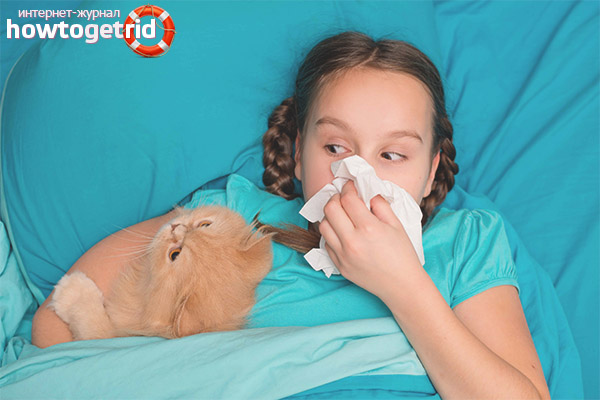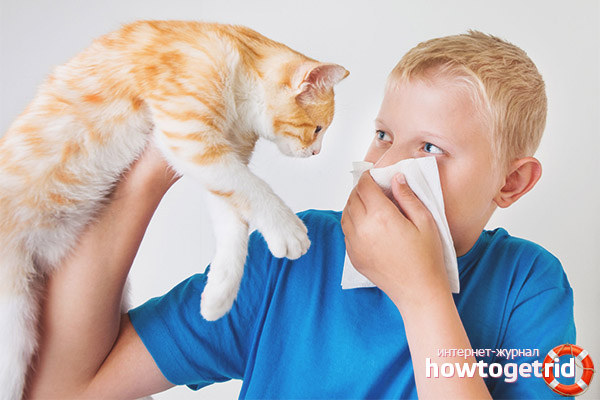The content of the article
An allergic reaction in people to various, even completely harmless substances, from year to year is becoming increasingly widespread. An allergy occurs on the pollen of any particular plants, ordinary foods, drugs, and other substances. Every fourth inhabitant of our planet suffers from an allergy to a particular substance. Moreover, every tenth person is allergic to cats, that is, to substances that are produced in the body of these animals.
This is a very common problem that affects people of all ages. She does not bypass the children. When an adult already knows that he is allergic to cats, he will never have such a pet. But, if there is a small child in the house, and his parents decide to have a cat, then no one knows if the baby is allergic to these pets. Sometimes, having acquired a cat, parents find that it was impossible to do this, as their child suffers from allergies. If the cat was in the apartment before the baby was born, after the child is brought home from the hospital, he may also show a strong reaction. After all, the particles still remained in the room, no matter how thoroughly the cleaning was done.
What are the causes of such an allergy? How to recognize it correctly? And is it possible to somehow overcome this problem?
Possible reasons
Cases of hereditary allergies are very common. But this does not mean that the parent and the baby will have an allergic reaction to the same thing. It often happens that allergens are different.
It is important to understand that scientists have long been disproved of an opinion on allergies to wool. In fact, the body of a person suffering from allergies does not respond to cat hair, but to certain proteins that make up urine, skin, and pet saliva. These proteins are called Felis Domesticus Allergen. The opinion that it was the wool that caused the allergy is due to the fact that most of this substance is found on the hair of the pet. But protein also settles on the floor, on all objects and surfaces that are in the apartment, including on children's furniture and toys.
An allergy can be caused not only by this substance, but also by others, which the cat usually brings from the street on its paws. This can be pollen of plants, and various spores of fungi. The pet food or filler that you put in its tray may also be an allergen.
Signs of an Allergy
The body can respond to an allergen instantly as soon as contact with the animal occurs, or the child was in the same room with him. But sometimes the reaction manifests itself only within a few hours. The signs of allergy in this case are very similar to the symptoms of various colds. Therefore, they can be easily confused.
Here are the main signs that indicate an allergic reaction to cats:
- When contact with an allergen occurs, redness of the eyes is observed. They begin to water.
- If contact with the allergen occurs within a few minutes, the child may begin to experience symptoms such as sneezing. In addition, the allergen causes discharge from the baby's nose, which is very reminiscent of a runny nose with a cold.
- A symptom is also a dry cough. Sometimes it becomes difficult for a child to breathe.
- If the baby plays with the cat, and after that he has scratches left, itching occurs in these places. The skin areas that are around the meta scratches turn red.
- The baby has a breakdown and lethargy, because of which parents can also suspect the onset of the development of influenza or the common cold.
- The skin in the nose and around the eyes begins to itch.
- Various rashes may appear.
Allergies to these furry pets in children can occur at any age, but most often this occurs in children aged 3 to 7 years. Sometimes it is very difficult for parents to determine that it is an allergy. The baby can communicate and play with his beloved pets for several years, and the first signs of allergies can occur after three years of age.
Scientists conducted research, as a result of which it turned out that if a child comes into contact with a cat almost from birth, then over time he has less chance of developing an allergy to a pet. Researchers attribute this to the fact that the baby’s body is simply getting used to the proteins that the cat’s body secrete.
Diagnostics
Since an allergy to cats has the same symptoms as a reaction to many other substances, it is visually impossible to determine. To understand that the child’s body responds to the cat in this way, it is necessary to consult an allergist who will conduct the diagnosis. In this case, such a technique is used that will be almost painless for the baby. A scratch is made on the skin, which is lubricated with a special solution. There are several types of such solutions. They contain one or another possible allergen. If a substance that causes an allergy in a child is present in one of the solutions, the reaction will appear within 20 minutes after contact with the skin. Near the scratch, the skin will begin to redden.
If you are almost sure that the child’s allergy is specifically for the cat, then this can certainly be determined by experiment. Give your pet to relatives or friends for a while. During this period, it is necessary to observe how the body will react to this. If, after you remove the cat from the house, the allergic reaction does not go “no”, this means that the allergen is some other substance. And the cat can be safely returned.
If you have a child in your home and you decide to have a cat, buy the animal with the child. This will greatly please the baby, as he will be able to choose a favorite for himself. In addition, you will be able to understand whether the child has an acute allergy to the future pet. It is important to remember that allergies do not necessarily occur immediately. Therefore, just in case, agree with the owners of the animal that in case of problems the animal can be returned.
How to fight

Unfortunately, scientists did not invent a tool that could defeat allergies. To combat its unpleasant manifestations, special drugs are used - antihistamines. They act on the body so that symptoms such as rashes, redness, itching and others disappear.
If you find out that your child has an allergic reaction specifically to a cat, then the child will have to completely stop communicating and contact with these animals. If the child really wants a pet, but you are afraid of allergies, it is better to give preference to a puppy. Indeed, in this case, the chances of allergies are several times reduced. But sometimes a cat is so beloved animal that it is simply impossible to give it to someone. In this case, it is necessary to take certain measures that will help minimize the amount of allergens in the house.
- Remove the elements of the environment from the house in which most particles of various substances accumulate. These are carpets on the floor, various rugs, etc. If possible, buy leather instead of upholstered furniture with fabric upholstery.
- It is very important to maintain perfect cleanliness in the home. In all corners and on all surfaces you need to wipe the dust. Wet cleaning in the house should be done daily.
- All textile items, such as curtains, bedspreads and bedding, must be washed as often as possible. The same applies to clothing.
- A pet will need to bathe at least every week.
- When the child is not at home, comb out the cat's hair every day. If possible, this should be done on the street.
- Change the filler in the tray more often.
- Ventilate the room several times a day, get an air purifier.
- Limit your baby’s contact with your pet. Do not give your child care tasks.
- Make sure that the cat is not in the room where the child sleeps and plays.
- Always keep antihistamines in your home.
Sometimes allergy is manifested by very dangerous symptoms. For example, laryngeal edema, asthma, etc. In this case, it is better to remove the pet from home. His presence in the house is too risky. If you really love your cat, give it to good friends or relatives. So you can sometimes visit him, and you will be sure that he is in good hands.
Are there hypoallergenic breeds
For those who suffer from allergies, but really want to get a cat, it will be a disappointment that there are no cats that do not cause an allergic reaction. But there are animals in which the concentration of allergen is slightly lower.
Less dangerous for children suffering from allergies are the following animals:
- Those individuals of both sexes who have undergone sterilization or castration prior to puberty.
- A small kitten will not produce many allergens. But, when he grows up, their number will increase.
- Cats produce less of these substances than cats.
- Pets with light hair are also safer.
It is believed that cats that have no hair at all, or those that have curly and very short hair, are hypoallergenic. But these pets will still produce an allergen, only in a smaller amount, plus monitoring the purity of such animals is somewhat easier.
Video: children and animal allergies










Submit